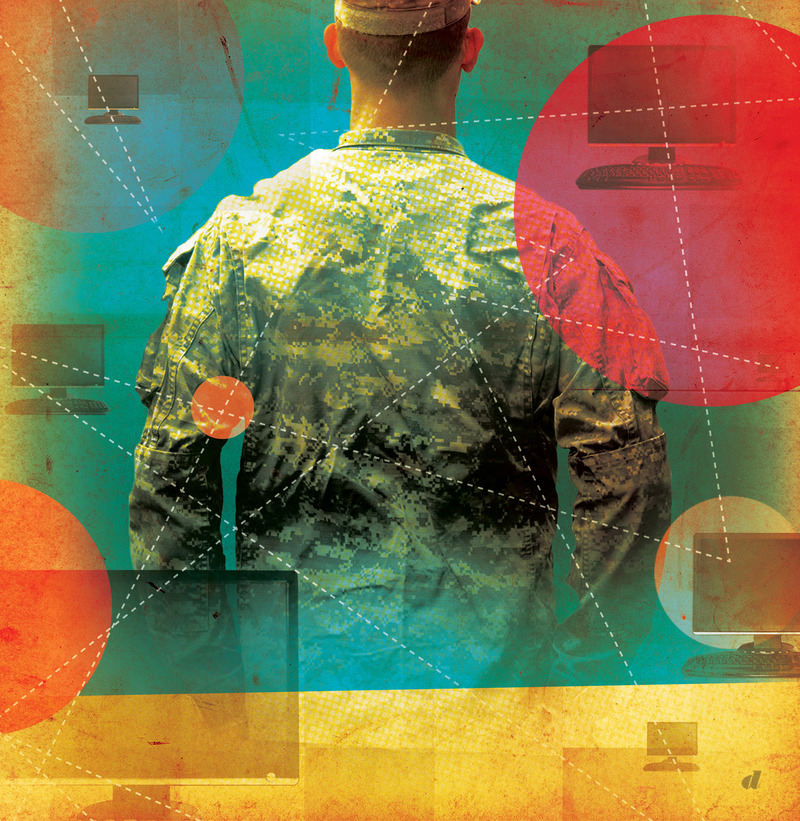The Local newsletter is your free, daily guide to life in Colorado. For locals, by locals.
On a late summer afternoon, about 20 miles east of the nation’s capital, an elite group of military personnel gathers in a small room. Creaking chairs and occasional chatter punctuate the soft hum of technology. A digital intel map is prominently displayed at the front of the room. Twenty-six-year-old Marine Gabe Martinez and Army reservist Keith Robinson affix their gazes on the screen, waiting for the map to update.
The pair are unlikely battle buddies. Martinez, a Westminster native, joined the Marines straight out of high school. The explosive ordnance specialist was on his second deployment in Afghanistan when he stepped on a 20-pound IED. He lost both of his legs. More than 20 years his senior, Robinson spent 26 years as an Army reservist with two deployments to Afghanistan, one to Iraq, one to Kosovo, and another to Bosnia before torn hip and knee tendons ended his career as a soldier. Surrounding them in the room are about 20 other wounded soldiers, sailors, and special operations personnel whose injuries have cut short their combat military careers—but not their abilities nor their desires to serve the country.
Eventually, the intel map loads. First one red dot appears. Then another. In a single minute, the screen is covered—except these dots don’t represent foreign foes. Martinez and Robinson are watching a map of the United States populate in real time with people who are actively distributing child pornography on the internet. And it takes only 60 seconds for the entire country to become a red sea of sexual predators.
In 2008, the U.S. Department of Justice ran a daily search for child-pornography traffickers in the United States. Every day they identified 20,000 distributors—and that’s just counting traffickers who were involved in the most graphic and brutal forms of exploitation. In 2015, Homeland Security Investigations (HSI) processed enough hours of child-pornography video to run for 77 years straight. The volume of such abuse inhabiting the dark—and often not-so-dark—corners of the internet is so massive that law enforcement doesn’t have enough computer forensic analysts to track it all. That’s precisely why three very different organizations recently came together to form a unique veteran transition program known as HERO Child Rescue Corps (HERO is an acronym for Human Exploitation Rescue Operatives).
Established in 2013, HERO Corps is a joint program between the nonprofit National Association to Protect Children (Protect), U.S. Special Operations Command (USSOCOM), and U.S. Immigration and Customs Enforcement (ICE) that trains wounded former military personnel as computer forensic analysts who help track down child pornographers. After their initial training, HERO Corps candidates complete unpaid internships at Homeland Security Investigations field offices across the country. Martinez and Robinson, along with former Army Captain Matt Closson, are the first to have completed their internships in Colorado.
Initially, HERO Corps was limited to mostly former special operations forces. “You have highly skilled, highly trained, mission-oriented individuals who have lost their abilities to fight the fight they thought they’d be engaged in,” says Protect CEO J. Christian, a former Army Ranger and HERO graduate himself. “Who could be a better asset?” ICE signed on in April 2013, and four months later, the first class of 17 HERO Corps recruits reported for training to Tennessee’s Oak Ridge National Laboratory (one of the sites where the atomic bomb was developed in the 1940s).
If it seems strange that the country’s customs enforcement agency is involved in investigating child pornography, consider the crime’s origin: Before the internet, pornographic material was sent through the mail—and international mail is the domain of customs. In fact, ICE leads the nation in investigating and prosecuting child-exploitation crimes; of all the data the agency seizes annually in its enforcement of more than 400 statutes, including money laundering and drug smuggling, more than half is related to child pornography.
ICE’s reputation as a leader in that field led Protect to ask for the agency’s help when creating HERO Corps. The success of the program’s first two classes—every HERO graduate was offered a job following his or her internship—encouraged Congress to pass the HERO Act of 2015, which formally established a partnership between the program and Homeland Security. (The HERO Act also allocated funding for HSI to hire HERO graduates, but the nonprofit Protect provides the $1.8 million required annually to train them. And while the internships are technically unpaid, some HEROs use their GI Bill and Vocational Rehab benefits for support.) Last year, HERO Corps expanded to two classes of 24 students drawn from all branches of the military. Closson was in the first. Martinez and Robinson joined the second.
Before they ever reached their internships in Colorado, Closson, Martinez, and Robinson underwent months of technical training at the elite ICE Cyber Crimes Center, where HSI agents go through the same rigorous coursework. That involves eight hours of class time followed by four hours of homework, Monday through Saturday. In their sixth week of training, students have two chances to pass two sections of a test; fail and they’re out of the program.
Before the technical work, HERO Corps candidates spend three weeks at Protect’s Weiss Center for Child Rescue to prepare for the disturbing content they’ll experience in the field. In one of the first demonstrations, an instructor logs into a chat room under a profile of a young girl. In Robinson and Martinez’s class, it took three minutes for a predator to contact the instructor and turn the conversation sexual; two minutes after that, the person sent the instructor a photo of his genitalia. “It’s similar to your first firefight,” Closson says. “You can train for it, you can think about it, you can be prepared, but you don’t really know how you’re going to react until you’re shot at.”
Closson never really wanted to be anything other than a soldier. From the age of five, the Pleasanton, California, native plastered his walls with military posters and decorations. Closson was in high school when the twin towers fell; he pleaded with his parents to let him enlist at 17. They refused, suggesting Closson think about an ROTC program instead. He did, and after graduating with a degree in history from the University of California, Davis, eventually became a captain in the Army’s infantry. But when Closson returned from a 2012 deployment to Afghanistan with bulging discs and other back issues, the Army told him that his body was too broken to continue and issued a medical discharge. The ambitious 27-year-old was crushed by the news. Before leaving Fort Carson, Closson heard about HERO Corps and was intrigued. After several weeks of interviews, background checks, and psychological screenings (to ensure potential HEROs can handle the brutal nature of the work), Closson was on his way to D.C. for the program’s training.
For those who survive ICE’s technical gauntlet, the real learning begins once they arrive at their 10-month internships in HSI field offices around the country. Interns process computers, phones, video, and other evidence. They venture into the field with HSI agents on search warrants and even predator ops (think NBC’s How To Catch A Predator). “My biggest fear was being thrown behind a desk,” Martinez says. “I wanted to be able to be an active part of something I can be proud of.” Of course, the interns also spend hours staring at heinous images, scanning for clues that could reveal where a particular image was taken so they might be able to identify—and save—the victim. (Finding victims remains HERO Corps’ priority.) And every hour they spend in the lab means an hour an HSI agent can be out chasing down another trafficker. “These are people who have been able to separate the horrors that they saw in war and deal with it in a healthy way,” says Dani Bennett, HERO Corps’ spokesperson. “They are people who have the desire to do the tough job a lot of people would say no to.”
This fall, HERO Corps will graduate its 100th HERO. With a job placement rate of about 90 percent, HERO Corps is one of the country’s most successful veteran employment transition programs. Both Martinez and Robinson completed their internships at the HSI field office in the Denver Tech Center in August. Martinez recently accepted a full-time position in Colorado with HSI.
For his part, Robinson views the job as a second chance: A probation officer for 17 years, his career included a stint with a caseload that focused on sex offenders. As a father of three young children at the time, Robinson couldn’t bring himself to look at the parolees, never mind work with them. So he requested a different caseload. “Fast-forward 10 years, and I get a chance to go back and put those guys away,” he says. “It felt like a real opportunity to redeem myself.”
For Closson, who began a full-time job with HSI in April, HERO Corps has provided an especially strong sense of satisfaction. When he was stationed in rural Afghanistan, the young captain struggled with the cultural traditions of some of the locals he worked with. When an Afghan teenager was raped, for example, Closson was horrified to learn that her own father then raped and murdered her to restore his family’s honor. But he was unable to do anything about it: At the time, American troops often faced potential violence—even gunfire—from “friendly” Afghans because of real or perceived cultural slights. “Telling the Afghans that they were wrong would have meant endangering my guys,” Closson says. “And my priority was bringing my boys home.”
Now, as an HSI computer forensics analyst who works largely with Colorado’s Internet Crimes Against Children Task Force, protecting young victims like that Afghan teen is precisely his goal. “I’ve always had a ‘send me’ personality,” Closson says about the unsettling work of tracking down child pornographers. Recently, the HERO Corps grad got his first victory. After spending four months painstakingly making his way through 30 terabytes of material, the subject of Closson’s investigation was finally arrested this summer thanks in part to his computer forensic work. The arrest was not only an important professional milestone for Closson, but it also signaled that he was exactly where he wanted to be: back in the fight.









